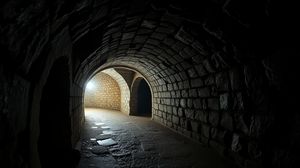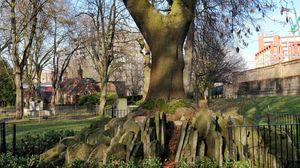
The Blue Plaque dedicated to George Orwell is located in the charming Canonbury Square, London, and commemorates the famous novelist and essayist who lived there from 1944 to 1947. Orwell, whose real name was Eric Arthur Blair, is most well-known for his seminal works "1984" and "Animal Farm." The plaque serves as a historical nod to Orwell's time spent in this vibrant area of Islington, where he resided during a significant period of his writing career.
Orwell's residence in Canonbury Square was during the time he penned "Animal Farm," which was published in 1945. This particular novel, an allegory of the Russian Revolution and subsequent Soviet regime, established Orwell's reputation as a master of satire and critical thought. Visitors to the plaque can imagine the environment in which Orwell cultivated his ideas and narratives that have since become timeless commentaries on society.
The architecture of Canonbury Square itself echoes the Georgian elegance for which the area is renowned, providing an atmospheric backdrop for reflecting on Orwell's life and legacy. The square and its surroundings have changed little since Orwell's time, allowing visitors to connect more closely with the historical ambiance that may have influenced his work.
An interesting tidbit about George Orwell is his penchant for assuming different identities. Before adopting his famous pen name, Orwell tried various pseudonyms, including "Kenneth Miles" and "H. Lewis Allways," before settling on the name by which he is celebrated today. This choice of aliases reflects his contemplative approach to self-identity, a theme prominent in his literary explorations.
While Orwell's writing often delved into serious and critical themes, it's lesser known that he had a dry wit and was an enthusiastic lover of everything quintessentially British, including a passion for English pubs. In fact, Orwell wrote an essay describing his ideal pub, "The Moon Under Water," which provides a delightful insight into his preferences and imaginings beyond his more serious topics.
Canonbury Square offers more than just a link to Orwell's literary heritage. It hosts a tight-knit community with a vivid history of intellectual and artistic inhabitants, fostering a creative environment that continues to attract residents and visitors alike. This blend of historic significance and vibrant cultural life makes a visit to George Orwell's Blue Plaque in Canonbury a thought-provoking experience.

Making the Most of Your Visit:
Take a leisurely stroll around Canonbury Square to get a sense of the place. The Square still retains its Georgian charm, and as you wander, imagine Orwell walking these same paths while writing "Animal Farm." Try to visit during quieter times for a more atmospheric experience.
Dive into a bit of literary exploration by bringing along a copy of Orwell's "Animal Farm" or his essay on the ideal pub, "The Moon Under Water." Find a bench, bask in the ambiance, and read a few pages while reflecting on the surroundings that inspired Orwell.
Since Canonbury is a residential area, respect the peace and privacy of its inhabitants while visiting the plaque. Keep noise levels down and be mindful of private properties as you explore the neighborhood.
Photography enthusiasts should bring a camera. The area's architecture and scenic beauty, especially during the golden hour, could provide some stunning shots that capture the essence of this historic spot.
Explore nearby literary connections! There are other famous writers who have lived in the Islington area. Do a little research before your visit, and plan a mini literary tour to see how the neighbourhood has been a backdrop to many great minds.

Visiting Times & Costs:
The Blue Plaque dedicated to George Orwell in Canonbury is publicly viewable and located on the exterior of a residential building. As such, it is accessible at all times. There is no entrance fee associated with visiting the plaque since it is located in a public area.
Accessibility for those with limited mobility may vary, as the plaque is situated in a residential area that might include uneven pavements or steps. However, Canonbury Square itself is generally accessible for visitors.

Address & Map:

Nearby:























